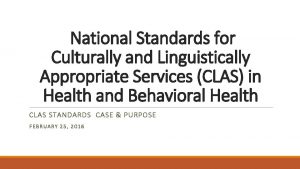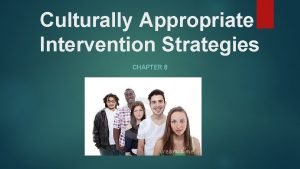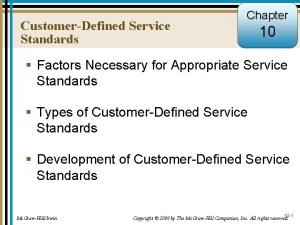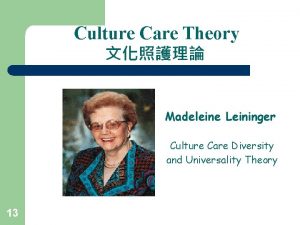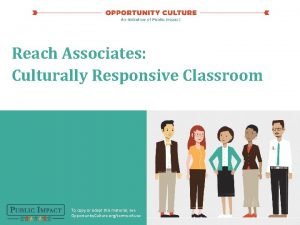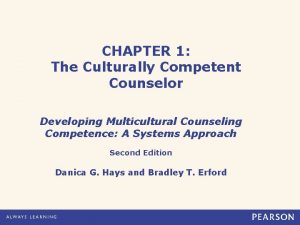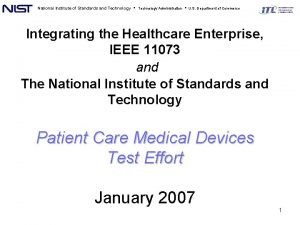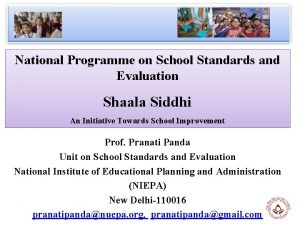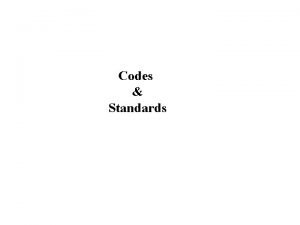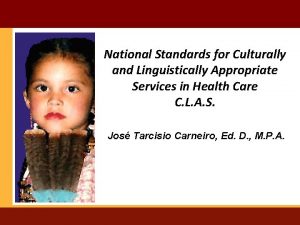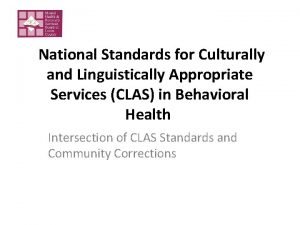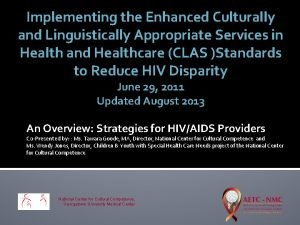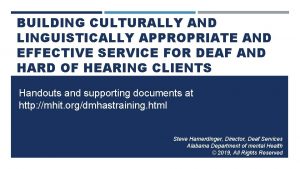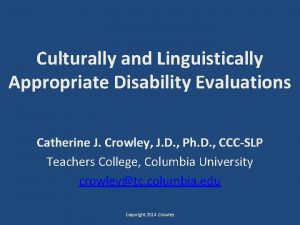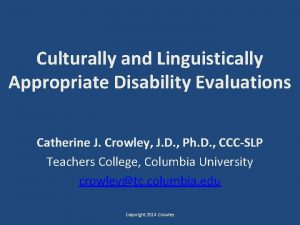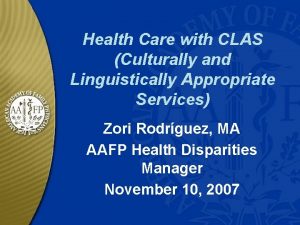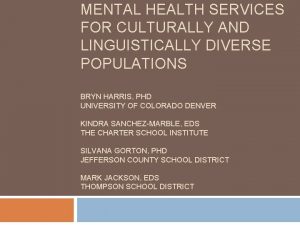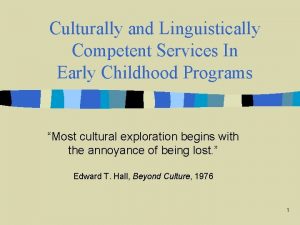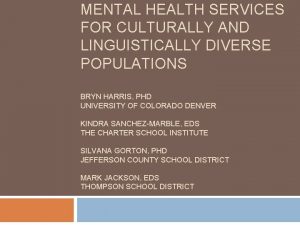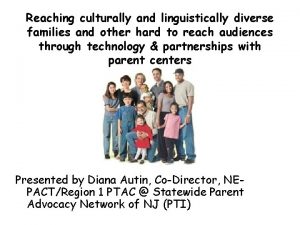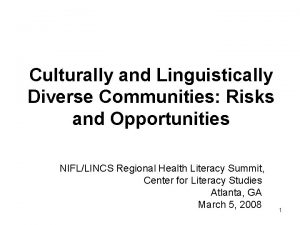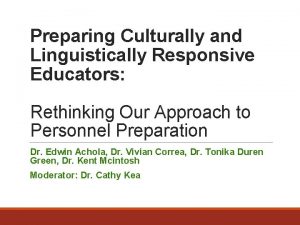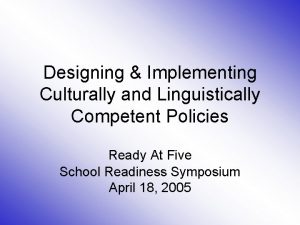National Standards for Culturally and Linguistically Appropriate Services























- Slides: 23

National Standards for Culturally and Linguistically Appropriate Services (CLAS) in Health and Behavioral Health CLAS STANDARDS CASE & PURPOSE FEBRUARY 25, 2016

Deborah Ward-White Executive Director Colorado Multi Ethnic Cultural Consortium (CMECC)/ Family Agency Collaborative (FAC) dwardwhite. fac@gmail. com 720 -299 -3516 FEDERATION OF FAMILIES FO R CHILDREN’S MENTAL HEALTH STATEWIDE FAMILY NETWO RKCULTU RALLY AND LINGUISTIC ALLY CO MPETENT (CLC) COORDINATION

Agenda § Rationale and Case for The National Standards for Culturally and Linguistically Appropriate Services (CLAS Standards) §The CLAS Standards 1 -15 § The Purpose of The CLAS Standards § Q&A discussion § Resources

Rationale for The CLAS Standards • Expand Scope of Service Delivery • Ensure Balance in Health / Behavioral Health Equity • Purpose in Reduction of Disparities • Meet Legislative, regulatory and accreditation mandates • Decrease risk of liability/malpractice

CLAS Standards History • Year: December 22, 2000 Office of Minority Health- First Published • Framework Originally to Serve Diverse Communities, Now Expanded to extended cultural domains. Eliminate long standing health disparities • Year 2010 Office of Minority Health Launch New Initiative Nationally • Joint Commission Members: HHS, Office of Minority Health; U. S. Dept of Justice, Office of Civils Rights; Health and Hospitals, Public Health Framework; CDC Action Steps for Prevention Standards; SAMHSA-HRSA Children, Families, Consumer Health Information Coordination, Ctr for Medicaid and Medicare Svs; Nat’l institute of Health (NIH); Indian Health Svcs ; Admin. for Preparedness and Response, Nat’l Admin. For Community Planning and Living, including Transportation and Immigration. • Year : 2013, April 24 th Release of Revised Version

Principal Standard # 1 Provide effective, understandable and respectful quality care and services that are responsive to diverse, cultural health beliefs and practices, preferred languages health literacy, and other communication needs. Purpose -Standard # 1 comprehensive and encompass other 14 standards, develop , provide, promote, informed, inclusive, culturally appropriate health care standards, protocols, programs, services that meet the needs of families, children and young adults.

THEME 1: Governance, Leadership and Workforce Standards # 2 thru # 4: #2 -Advance and sustain organizational governance and leadership that promotes CLAS and Health equity through policy, practices and allocated resources. #3 - Recruit, promote and support a culturally and linguistically diverse governance, leadership and workforce that are responsive to the population in service area. #4 Educate and train governance, leadership and workforce in culturally and linguistically appropriate policies and practices on an ongoing basis.

THEME 2: Communication and Language Assistance # 5 - Offer language assistance to individuals who have limited English proficiency and/or other communication needs at no cost to them, to facilitate timely access to all health care, services and supports. #6 - Inform all individuals of the availability of language assistance services clearly and in their preferred language , both verbally and in writing. #7 Ensure the competence of individuals that provide language assistance, recognize that use of untrained individuals and/or minors as interpreters should be avoided. #8 - Provide easy to understand print and multi-media materials and signage in the languages commonly used by the populations in the service area.

THEME # 3: Engagement, Continuous Improvement, and Accountability Standards # 9 -#11 §#9 -Establish culturally and linguistically appropriate goals, policies and management accountability and infuse them throughout the organization’s planning and operations §#10 -Conduct ongoing assessments of the organization’s CLAS Standards related activities and integrate –CLAS- related measures into measurement and continuous quality improvement activities. §#11 - Collect and maintain accurate and reliable demographic data in order monitor and evaluate the impact of CLAS on health equity and outcomes to inform service delivery.

THEME #3: Engagement, Continuous Improvement and Accountability Standards # 12 - # 15 # 12 -Conduct regular assessments of community health assets and needs; use the results to plan and implement services that respond to the cultural and linguistic diversity of populations in the service area. # 13 -Partner with the community to design, implement and evaluate policies, practices and services, in order to ensure cultural and linguistic appropriateness. #14 -Create conflict and grievance resolution processes that are culturally and linguistically appropriate in order to identify, prevent, and resolve conflicts or complaints. # 15 -Communicate the organization’s progress in implementing and sustaining CLAS Standards to all stakeholders, constituents and the general public.

Purpose of Standards # 2 -# 4 § Standards § #2 Promote Cultural Competence in Governance and Leadership; Prepare, Train and Support Diverse Representation on Boards, Commissions and Councils. § # 3 Develop and Ensure a Culturally Competent Workforce § #4 Inform, Educate the Role of a Culturally Responsive Governance

Purpose: Standards # 5 Thru #8 Standards # 5 Purpose-Ensure that person who have LEP are able to access information, programs and services at a level equal to those that are English proficient. #6 Purpose- Inform those in your service area of the capacity to provide communication, language assistance in the individuals preferred language, including ASL. #7 Purpose- Ensure qualified professionals are available to assist and interpret language and communication for those seeking services in your service area. Ensure that the language assistance is meaningful, respectful and delivers the accurate message, meaning, communication of the individual, family, youth, young adult seeking services from your agency, organization. #8 Purpose –Encourages Communication with signage, forms, ROA, ROI, Procedures, Protocols, etc. is readable in the preferred languages of those seeking services.

Purpose: Standards # 9 Thru #11 ◦Standards # 9 -#11 ◦#9 Purpose- Make CLAS Central to Organization’s Service, Administration and Support Staff. ◦ Integrate CLAS Standards throughout organization, including the mission, highlight the importance of specific goals related to CLAS Standards ◦Link CLAS standards to organization, agency policy, practices and decision making process and outcomes and accountability policies. ◦#10 Purpose- Assess performance, monitor progress of implementing the CLAS Standards, obtain information on the people, families, youth, young adults to be served in order to tailor, improve service delivery. ◦#11 Purpose- Identify population , community within org’s service area, monitor the families, children, youth, young adult exact needs, ensure allocation of resources, improve service planning care coordination, ensure services are delivered equitably.

Purpose: Standards #12 Thru #15 Standards #12 thru #15 §# 12 Purpose Determine service assets and needs of the population in the very service area. (Needs Assessment). Identify services available and not available to the population seeking services in your service area. ( resources, gaps and barrier analysis)Ensure demographic, cultural, linguistic, epidemiological data ( both quantitative and qualitative). Update data on regular intervals. §#13 Purpose – Provide culturally responsive, appropriate service delivery in community, ensure are guided and informed by the community represented in org’s / agencies service area, engage, empower culturally informed leaders and community in order to effectively design and improve services to meet the needs of those families, youth , young adults seeking services. §#14 Purpose To Facilitate transparent open dialogue and feedback between consumers and agencies/ org’s; identify/ respond to cross cultural needs, meet Federal, State regulations on grievance, discrimination procedures. §# 15 Purpose – To Convey to the intended audiences about efforts, progress of meeting the implementation goals of the CLAS Standards, gain input from organizations on ideas/ approaches to implementing the CLAS Standards, meet reporting requirements, including accountability in meeting health care objectives.

Factors/Discussion ● Describe the factors that support and promote the implementation of these standards in your Organizations/ Agencies. ● Describe the factors that function as barriers to the implementation of these standards in your Organizations/ Agencies.

References &Resources for CLAS Standards Implementation Federal Anti Discrimination Law Title VI – Civil Rights Act of 1964 Americans with Disabilities Act (ADA) 1988 and July 16, 1990 ADA Amendments Act of 2008 Affordable Health Care Act ( AHCA )– Mandate to Align Care and Culture AHCA- Implement the Advancing Health Equity for Ethnically Diverse Populations Section 5307 - Cultural Competence and Organizational Support. Georgetown University -Center for Cultural Competence for Children and Families SAMHSA Technical Assistance ( T. A. ) Network www. integration. samhsa. gov SAMHSA-HRSA Center for Integrated Health Solutions-Understanding The CLAS Standards U. S. Dept. of Health and Human Services- HHS. gov- Think Cultural Health

Understanding the importance of inclusion for Families, Youth, Young Adults, Family Lead Partnerships, FRO in the Community Margie Grimsley Federation of Families for Children’s Mental Health~CO Chapter SAMHSA-Statewide Family Network Grant 720 855 -3493 Office; 1 844 -252 -8202 Toll Free Number 303 455 -5928 (Home Office) M_grimsley@msn. com (m_g) www. coloradofederation. org 17

Image moving beyond. . . Not only a time when we can stop talking about how to “partner”, “involve”, “engage”, and with families, youth, family-organizations and it just is the way it is?

19

But also are able to: Provide culturally responsive, appropriate service delivery in community, ensure are guided and informed by the community represented in org’s / agencies service area, engage, empower culturally informed leaders and community in order to effectively design and improve services to meet the needs of those families, youth , young adults seeking services. (CLAS Standard #13)

Promoting a Culture of Trust MISTRUST: For example, the “Belief that an agency /or worker will do harm. ” TRUST: “At first I kept to myself, but when I felt they weren’t out to get me, I related and then it was ok. Trust and feeling like they are Really there is important to me. ” “There is an old children’s saying, “Sticks and stones may break my bones, but words can never hurt me. ” If only that were true, bit it’s a fable that needs to be laid to rest. Words can hurt a lot more than sticks and stones. They may not break bones, but they can surely brake hearts. Words can devastate. Words can wound; Words can kill. Words can ruin reputations and destroy relationships. There’s not doubt about it-Words can hurt. ” Lonnette Harrell

A Place to start: Recognizing That Words DO Matter From a Organizational, Professional, and Personal perspective: 1. 2. 3. 4. Are my words positive or negative? Who is hearing them? Who is interpreting them? And in what situation are they being spoken or written? From ‘CLOSING THE GAP: CULTURAL PERSPECTIVES ON FAMILY-DRIVEN CARE”

Want to know more? Join us to continue this discussion, by becoming part of the CO Federation’s Statewide Family Network Advisory Team. CO Federation Office: 720 855 -3493 Toll Free Number: 1 844 -252 -8202
 National culturally and linguistically appropriate services
National culturally and linguistically appropriate services Working with culturally and linguistically diverse families
Working with culturally and linguistically diverse families Culturally responsive vs culturally relevant
Culturally responsive vs culturally relevant Culturally appropriate intervention strategies
Culturally appropriate intervention strategies Culturally responsive teaching and the brain powerpoint
Culturally responsive teaching and the brain powerpoint Factors necessary for service standards are
Factors necessary for service standards are Hard and soft service standards examples
Hard and soft service standards examples Cultural deprivation
Cultural deprivation Vdoe culturally responsive teaching
Vdoe culturally responsive teaching Culturally congruent care definition
Culturally congruent care definition Madeleine leininger's sunrise model
Madeleine leininger's sunrise model Culturally responsive teaching in music education
Culturally responsive teaching in music education Classroom
Classroom Reach associates
Reach associates Culturally competent counselor
Culturally competent counselor Culturally relevant pedagogy
Culturally relevant pedagogy National institute of standards and technology
National institute of standards and technology How to write mission statement in shaala siddhi
How to write mission statement in shaala siddhi Codes standards and practices lesson 1
Codes standards and practices lesson 1 Measurement units standards and services department
Measurement units standards and services department National unification and the national state
National unification and the national state Kontinuitetshantering
Kontinuitetshantering Novell typiska drag
Novell typiska drag Tack för att ni lyssnade bild
Tack för att ni lyssnade bild
